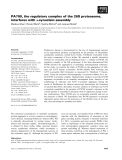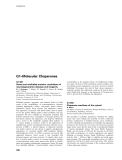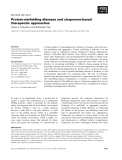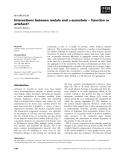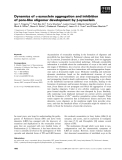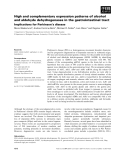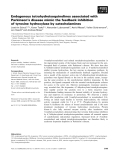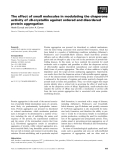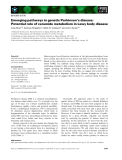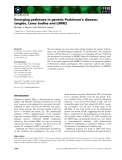


Parkinson’s disease
-
Patients with Parkinson’s disease experience physical decline due to the disease’s relentless progression, which may cause them unable to perform activity daily living. This study aimed to explore some factors related to ADL and IADL dependencies among older people with Parkinson’s disease.
 8p
8p  vihizuzen
vihizuzen
 26-05-2025
26-05-2025
 1
1
 1
1
 Download
Download
-
Bài giảng Bệnh Parkinson (Parkinson’s Disease), được biên soạn với mục tiêu nhằm giúp các bạn sinh viên có thể trình bày được triệu chứng lâm sàng của bệnh Parkinson; Trình bày được mục tiêu điều trị và các nhóm thuốc điều trị bệnh Parkinson. Mời các bạn cùng tham khảo!
 21p
21p  laphongkim0906
laphongkim0906
 24-04-2025
24-04-2025
 0
0
 0
0
 Download
Download
-
Bài viết mô tả đặc điểm rối loạn lo âu và chất lượng cuộc sống ở bệnh nhân (BN) Parkinson có rối loạn lo âu tại Bệnh viện Lão khoa Trung ương. Phương pháp nghiên cứu: Nghiên cứu mô tả cắt ngang trên 98 BN Parkinson, thực hiện các đánh giá bằng Thang điểm đánh giá lo âu Hamilton (Hamilton Anxiety Rating Scale - HAM-A) và bộ 39 câu hỏi chất lượng cuộc sống BN Parkinson (39-item Parkinson's Disease Questionnaire - PDQ-39) tại Bệnh viện Lão khoa Trung ương từ ngày 01/01 - 31/8/2024.
 9p
9p  viaburame
viaburame
 14-03-2025
14-03-2025
 4
4
 1
1
 Download
Download
-
Bài viết trình bày đánh giá đặc điểm một số triệu chứng vận động ở bệnh nhân (BN) Parkinson khởi phát sớm (early-onset Parkinson’s disease - EOPD). Phương pháp nghiên cứu: Nghiên cứu tiến cứu, mô tả cắt ngang có phân tích trên 135 BN EOPD từ tháng 4/2019 - 12/2021. BN được khám theo mẫu bệnh án thống nhất. Đánh giá mức độ bệnh và thể bệnh theo thang điểm MDS-UPDRS (unified Parkinson's disease rating scale), giai đoạn bệnh theo Hoehn và Yahr.
 8p
8p  viaburame
viaburame
 14-03-2025
14-03-2025
 5
5
 1
1
 Download
Download
-
Regulator of G-protein signaling (RGS) proteins were originally identified as negative regulators of G-protein-coupled receptor (GPCR) signaling via their GTPase-accelerating protein (GAP) activity. All RGS proteins contain evolutionarily conserved RGS domain; however, they differ in their size and regulatory domains. RGS1 and RGS10 are smaller than other RGS proteins, and their functions involve various inflammatory responses including autoimmune responses in both the periphery and the central nervous system (CNS). Neuroinflammation is the chronic inflammatory response in the CNS.
 5p
5p  caothientrangnguyen
caothientrangnguyen
 09-05-2020
09-05-2020
 31
31
 2
2
 Download
Download
-
Regulator of G protein signaling (RGS) proteins are gatekeepers regulating the cellular responses induced by G protein-coupled receptor (GPCR)-mediated activation of heterotrimeric G proteins. Specifically, RGS proteins determine the magnitude and duration of GPCR signaling by acting as a GTPase-activating protein for Gα subunits, an activity facilitated by their semiconserved RGS domain. The R7 subfamily of RGS proteins is distinguished by two unique domains, DEP/DHEX and GGL, which mediate membrane targeting and stability of these proteins.
 13p
13p  caothientrangnguyen
caothientrangnguyen
 09-05-2020
09-05-2020
 30
30
 1
1
 Download
Download
-
Parkinson’s disease is characterized by the loss of dopaminergic neurons in the nigrostriatal pathway accompanied by the presence of intracellular cytoplasmic inclusions, termed Lewy bodies. Fibrillized a-synuclein forms the major component of Lewy bodies. We reported a specific interaction between rata-synuclein and tat binding protein 1, a subunit of PA700, the regulatory complex of the 26S proteasome.
 11p
11p  fptmusic
fptmusic
 11-04-2013
11-04-2013
 42
42
 2
2
 Download
Download
-
Misfolded proteins, aggregates, and inclusion bodies are hall-marks of the cytopathology of neurodegenerative disorders including Huntington’s disease, Amyotropic lateral sclerosis, Parkinson’s disease, Prion diseases, and Alzheimer’s disease. The appearance of proteins with altered folded states is regula-ted by the protein folding quality control machinery and age-dependent. We have identified an unexpected molecular link between metabolic state, accumulation of damaged proteins, the heat-shock response and chaperones, and longevity....
 61p
61p  fptmusic
fptmusic
 11-04-2013
11-04-2013
 46
46
 5
5
 Download
Download
-
Neurodegenerative disorders, such as Huntington’s, Alzheimer’s, and Parkinson’s diseases, affect millions of people worldwide and currently there are few effective treatments and no cures for these diseases. Transgenic mice expressing human transgenes for huntingtin, amyloid precursor protein, and other genes associated with familial forms of neurodegenerative disease in humans provide remarkable tools for studying neurodegeneration because they mimic many of the pathological and behavioural features of the human conditions. ...
 15p
15p  awards
awards
 06-04-2013
06-04-2013
 39
39
 4
4
 Download
Download
-
A large number of neurodegenerative diseases in humans result from pro-tein misfolding and aggregation. Protein misfolding is believed to be the primary cause of Alzheimer’s disease, Parkinson’s disease, Huntington’s disease, Creutzfeldt–Jakob disease, cystic fibrosis, Gaucher’s disease and many other degenerative and neurodegenerative disorders.
 19p
19p  inspiron33
inspiron33
 26-03-2013
26-03-2013
 69
69
 5
5
 Download
Download
-
a-synuclein is one of a family of proteins whose function remains unknown. This protein has become linked to a number of neurodegenera-tive disease although its potential causative role in these diseases remains mysterious. In diseases such as Parkinson’s disease and Lewy body demen-tias, a-synuclein becomes deposited in aggregates termed Lewy bodies.
 9p
9p  galaxyss3
galaxyss3
 21-03-2013
21-03-2013
 56
56
 4
4
 Download
Download
-
Accumulation ofa-synuclein resulting in the formation of oligomers and protofibrils has been linked to Parkinson’s disease and Lewy body demen-tia. In contrast, b-synuclein (b-syn), a close homologue, does not aggregate and reducesa-synuclein (a-syn)-related pathology.
 16p
16p  galaxyss3
galaxyss3
 21-03-2013
21-03-2013
 42
42
 3
3
 Download
Download
-
Parkinson’s disease (PD) is a heterogeneous movement disorder character-ized by progressive degeneration of dopamine neurons in substantia nigra. We have previously presented genetic evidence for the possible involvement of alcohol and aldehyde dehydrogenases (ADH; ALDH) by identifying genetic variants in ADH1C and ADH4 that associate with PD.
 12p
12p  galaxyss3
galaxyss3
 21-03-2013
21-03-2013
 37
37
 4
4
 Download
Download
-
N-methyl-norsalsolinol and related tetrahydroisoquinolines accumulate in the nigrostriatal system of the human brain and are increased in the cere-brospinal fluid of patients with Parkinson’s disease. We show here that 6,7-dihydroxylated tetrahydroisoquinolines such asN-methyl-norsalsolinol inhibit tyrosine hydroxylase, the key enzyme in dopamine synthesis, by imitating the mechanisms of catecholamine feedback regulation.
 13p
13p  media19
media19
 06-03-2013
06-03-2013
 42
42
 4
4
 Download
Download
-
Parkinson’s disease (PD), a common progressive neurodegenerative disor-der, is characterized by degeneration of dopamine neurons in the substantia nigra and neuronal proteinaceous aggregates called Lewy bodies (LBs). The etiology of PD is probably a combination of environmental and genetic factors.
 8p
8p  media19
media19
 06-03-2013
06-03-2013
 30
30
 2
2
 Download
Download
-
L-3,4-Dihydroxyphenylalanine (L-dopa) remains the most effective phar-macological treatment for relief of the severe motor impairments of Par-kinson’s disease. It is very effective in controlling parkinsonian symptoms in the initial phase of the disease, but its action wanes with time. Such ‘wearing-off’ imposes an escalation in the dosage of the drug, which ulti-mately fails to provide stable control of motor symptoms and results in the appearance of abnormal involuntary movements or dyskinesia....
 8p
8p  media19
media19
 06-03-2013
06-03-2013
 35
35
 3
3
 Download
Download
-
Protein aggregation can proceed via disordered or ordered mechanisms, with the latter being associated with amyloid fibril formation, which has been linked to a number of debilitating conditions including Alzheimer’s, Parkinson’s and Creutzfeldt-Jakob diseases. Small heat-shock proteins (sHsps), such as aB-crystallin, act as chaperones to prevent protein aggre-gation and are thought to play a key role in the prevention of protein-mis-folding diseases.
 13p
13p  media19
media19
 05-03-2013
05-03-2013
 41
41
 4
4
 Download
Download
-
This review explores the possibility that acetylcholinesterase may play a pivotal, non-hydrolytic role in neurodegeneration. More specifically, C-ter-minal sequences of acetylcholinesterase may act as signalling molecules in key brain regions characteristically vulnerable to Alzheimer’s, Parkinson’s and motor neuron disease.
 8p
8p  media19
media19
 05-03-2013
05-03-2013
 29
29
 3
3
 Download
Download
-
Heterozygous loss-of-function mutations at the glucosecerebrosidase locus have recently been shown to be a potent risk factor for Lewy body disease. Based on this observation, we have re-evaluated the likelihood that the dif-ferent PARK loci (defined using clinical criteria for disease) may be misleading attempts to find common pathways to pathogenesis.
 7p
7p  vinaphone15
vinaphone15
 28-02-2013
28-02-2013
 53
53
 3
3
 Download
Download
-
The last decade has seen clear links emerge between the genetic determi-nants and neuropathological hallmarks of parkinsonism and dementia, notably with the discovery of mutations ina-synuclein and tau. Following the description of mutations in LRRK2 linked to Parkinson’s disease, char-acterized by variable pathology including eithera-synuclein or tau deposi-tion, it has been suggested that LRRK2 functions as an upstream regulator of Parkinson’s disease pathogenesis.
 10p
10p  vinaphone15
vinaphone15
 28-02-2013
28-02-2013
 30
30
 3
3
 Download
Download
CHỦ ĐỀ BẠN MUỐN TÌM













